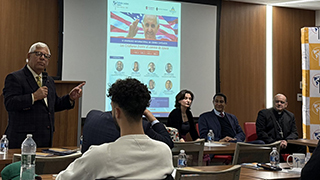New Research Reveals Irrational Behavior Prevents Optimal Investing - Seton Hall University
Friday, June 9, 2023

A new research report published in the Journal of Behavioral Finance finds that investors non-consciously use the amount of an initial investment as an anchor. When the initial amount is small, it causes people to underinvest in the future. According to the researchers, these "accidental" investing behaviors affect overall investment size.
Jennifer Itzkowitz, Ph.D., associate professor of finance in the Stillman School of Business, and Andrew Schwartz, Ph. D., assistant professor of finance, along with Jesse Itzkowitz, Ph.D., behavioral scientist at Ipsos, looked at the investment behavior of more than 150,000 individuals in their app-based stock brokerage accounts.
Among their key findings:
- The amount of all subsequent investments is strongly influenced by the initial investment amount.
- After the initial stock purchase, 19% of stock purchases are for the exact value as the first stock trade.
- Anchoring is prevalent among all groups of people including, men and women, young and old, people in all parts of the country.
- Over one year, a $1 increase in the amount of an investor's initial stock purchase results in a $4.63 increase in the total amount that an investor contributes to their investment account, all else equal.
According to the researchers, the amount of money you choose to make your first investment irrationally biases later investment amounts. This behavior, known as "anchoring", occurs when exposure to a number unconsciously influences subsequent decisions. This is contrasted against a purely rational strategy in which people decide how much money to invest based on their income and spending habits.
App-based trading platforms encourage users to start trading with extremely small amounts of money. For example, Stash advertises, "Investing made easy. Start with just $5." Although the amounts of money discussed here are small, the cumulative effect of many small-stakes decisions is large. If you start small, repeating the same investment amount causes suboptimal investment in the long run.
"Anchoring is extremely common and entirely accidental," said Jesse Itzkowitz. "It has been shown to affect all kinds of other decisions including jury sentencing, art auction prices, and real estate valuation. People have no idea they are doing it."
To confirm that investment amounts were based on irrational decisions and attributable to anchoring rather than rational decisions, the researchers observed the behavior of people who were given gift cards redeemable for stocks. A gift card's value is determined by the gift giver not the investor. The gift amount creates an irrelevant number for the investor to anchor on. The results confirmed that people anchored on the gift card value making later investments for at or near the same amount as the original gift card.
"A small change in the first amount of money that someone invests can have large differences in the long-run," said Jennifer Itzkowitz. Because people continue to invest the same amount of money as their first investment, starting off with a small amount leads to people investing less over time.
The researchers found that regardless of the amount of the first gift card, people did not trade more frequently or invest more often. On average, regardless of the amount of the first trade, people tended to invest a similar number of times each year.
The researchers further investigated groups of individuals to confirm that all types of people anchor. Additionally, they ruled out other behavioral theories such as inertial behavior and memory as causes.
"Minor changes in how information is presented to investors could make major differences in an individual's savings account over time," said Jesse Itzkowitz.
Whether spending, saving or investing, the results are generalizable to other situations. For example, it is rarely in someone's best interest to make the minimum payment required on their credit card. However, simply seeing it on a credit card statement creates an anchor. Webpages advertising "Begin Investing with just $100" may want to reconsider their own advice. And, to promote college savings, many state and local governments encourage parents to begin with just $25.
"While just getting over the hurdle to start investing is critical, it is not enough. We need to encourage people to save and invest an ideal amount money, not a minimum amount," said Jennifer Itzkowitz. "This research will assuredly impact the world of finance by cautioning everyday investors of the risks uninformed investing can pose,” said Dean Joyce Strawser. "Jennifer and Andrew’s work is reflective of the Stillman School of Business' mission by transforming investment concepts into sound business practice."
Recommendations
Based on their findings, the researchers make a series of recommendations to individual
investors, companies, and policy makers.
For Individual Investors:
- Identify your investment/savings goals before deciding how much to invest.
- Pre-commit to yourself to increase your investment amount over time.
- Perform research when alert, since other factors also contribute to anchoring bias. Most deal with fatigue, either mental or physical.
For Companies and Policy Makers:
- Rather than encouraging investors to start with the smallest possible amount of money to invest, encourage investors to start with an ideal amount of money.
- Encourage investors to increase their investment amounts over time.
- Offer investors a way to pre-commit to a larger future investment.
Methodology
Stock purchases of individual investors who use an app-based stock brokerage were
compared to their own initial purchase amount. Stock purchases can be for any amount
of money because the app allows for fractional stock purchases. Initial trades were
divided into two groups based on whether the first trade was self-funded or a gift
card redemption. Statistical tests controlled for other factors which might influence
purchase amount such as, total number of stock trades, account age, investor age,
gender, total portfolio value, investor income, current stock price, stock return,
and stock volatility.
Categories: Business






